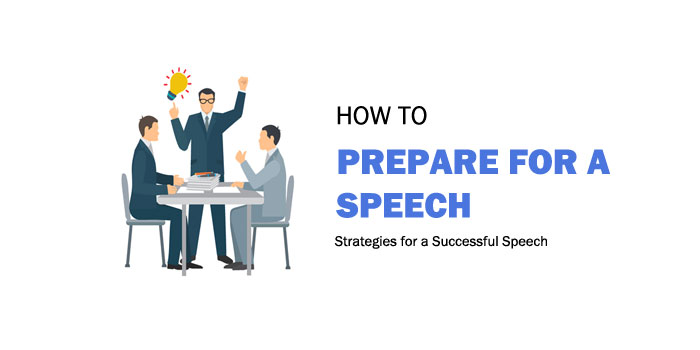How to Prepare for a Speech: Strategies for a Successful Speech
Are you nervous about your first public speaking experience?
Or are you excited and can't wait to express your thoughts to the audience?
Whatever the case, it is crucial to learn how to prepare for a speech so you can deliver a successful, heartfelt oration.
Whether speaking in a seminar, a board meeting, or a classroom, the better you prepare, the more confident you feel.
So, what are different useful strategies that can help you prepare better? Let's find out!
Things to Consider Before Preparing the Speech
There is a lot more that goes into preparing a speech than simply writing some notes and reading them out loud in front of the audience.
Here are some crucial things to consider before starting to write your speech.
Learn Your Audience
Knowing your target audience is essential to prepare an excellent speech that adequately conveys its message. You first need to check where you will deliver the speech and who your audience is.
Learn about your audience's different backgrounds and cultures. Avoid making cultural remarks during the speech, as what seems insignificant to you may stir others' emotions.
Try to find out their interests to make your speech light and relatable. Find out the age range of your audience. Speaking to young students requires a different game plan than speaking to experienced professionals.

Learn about the audience's knowledge and expertise on the subject of the speech. Is it something new, or are they well-versed on the subject?
It is best to avoid using thick jargon if the audience is inexperienced and new to the field, whereas with an experienced audience, you can take things to the next level.
Knowing your audience will also help you include relatable experiences from your own life, making the speech more interesting and fun to listen to.
Furthermore, from the audience's point of view, there must be a reason to listen to someone speak. In essence, you have to make sure that the speech you're going to give will offer value to the audience and their current situations. This feeds directly into the next point.
Understand the Purpose of Speech
What do you wish to achieve with this speech? What message do you need to deliver? The answer to these questions will help you shape your speech.
Take your audience on a step-by-step journey with your speech, and in the end, ensure they understand your end goal.
Sometimes, you want to deliver specific messages as is, whereas other times, you only wish to convey a thought-provoking speech.
Knowing the purpose or purposes of the speech will help you include interesting and relatable anecdotes that draw the audience's interest.
Try Out the Speaking Medium Beforehand
Technological advancements have touched every medium. You may present the speech to your audience face to face or via a virtual medium.
For instance, in the recent past, many companies and organizations conducted their conferences, meetings, and interviews via Zoom.

It is best to know what your speaking medium is beforehand. Knowing whether you will be presenting on the stage in front of a live audience, speaking via video platform, or going on the TV or radio can help you prepare accordingly.
Calculate the Duration of Your Speech
Knowing the duration of the speech is essential to prepare a targeted, engaging speech. The preparation for an hour-long speech is different from that of a five-minute-long speech.
Knowing the time duration will help you understand how many anecdotes, interesting facts, or examples you can include and how to structure your speech, so you keep the audience's attention throughout.
How to Prepare for a Speech
Next comes up writing the speech. A speech consists of the introduction of the subject, the main body, and a conclusion.
An engaging and meaningful speech contains a mix of facts, statistics, interesting anecdotes, fun phrases, and loads of relatable content. Here are a few easy and valuable tips for writing a powerful speech.
Step #1: Thoroughly Research Your Topic
A full grasp of the topic is essential to delivering a successful speech. Knowing every detail of the subject matter will give you the confidence to stand in front of your audience.
Whether you are presenting as a student in your classroom or as a president in your board meeting, the topic's knowledge will give you authority over the listeners. The same goes for presenting a subject with other group members.
You must thoroughly know the issue, whether you are presenting the introductory, central, or concluding parts of the speech. This knowledge will also help you later in the question/ answer session.
Step #2: Start With an Interesting Story or Question
Capture your audience's attention with an enticing and ear-catching introduction. Avoid going straight up to introduce your subject. Instead, start your speech with something fun, light, and breezy.
You can share an interesting fact, include any amusing little personal incident, or propose a mind-boggling idea.

The first few minutes of your speech are essential as they can make or break the audience's attention to what comes ahead. Deliver the most important pointers of your speech within this period and let the audience know they are in for a treat.
You might also like: 10 Engaging Ways to Start a Speech
Step #3: Take the Hook Down the Body of the Speech
Indeed, the first impression is the last impression. But all the high of the attention-grabbing introduction can go down the drain if the body of the speech lacks meaning, pull, and purpose.
Hence, it is necessary to give every part of your speech equal importance during preparation and at the time of delivery as well.
You will present your speech's main idea or purpose in the body. Therefore, you must make your content clear, easy to understand, intentional, and well-organized. Avoid adding unnecessary information.
Here's how to ensure the body of your speech is as good as your introduction.
How to Ensure Interest in Your Speech
- Make a String of Ideas: Create a chain of thoughts leading to the main idea or purpose of the sitting. An unorganized and haphazard speech will distract your audience, and they will lose interest. Aim for this part of your speech to connect with your audience.For instance, if you are preparing for a motivational speech, then this part should allow the audience to connect with your speech emotionally. They should start thinking about the main idea and purpose of this speech.
- Be Logical and Coherent: You should be logical, to the point, and clear while introducing and connecting different concepts. Make a central connection point of additional facts, statements, and ideas in the speech, and combine them with the main topic.
- Repeat Your Main Point Several Times: Repeat your main point throughout the main body without being obvious. Let the idea sync in the back of the audience's minds. Avoid using the same words repeatedly; use synonyms or relatable analogies instead. Listening to the repetitive logic will help the audience grab the core idea.
- Avoid Adding More Than Three Points: Try adding no more than three points to make the speech simple and easy to remember. Plus, include relevant examples explaining these points.
- Properly Arrange Different Ideas: Go through the central part of the speech and check if all the ideas or pointers are arranged systematically. The central part should take the listener on a journey that concludes with the final part of the speech.
- Write Main Part Before Introduction: The body comes next to the introduction of the speech. But it is best to research and write this part before the introduction. Writing this part will give you a clear idea of what you will say in the introduction and the conclusion.
Step #4: Remind the Audience of the Speech's Purpose in the Conclusion
A well-written and efficiently delivered speech keeps the audience captivated throughout.
If it's effectively presented, a speech hooks the listeners right from the introductory sentence, goes hand in hand through the central body, and becomes part of the memory with a great ending.
Hence, continue working on the speech's conclusion with the same zeal and effort as you have worked on the introduction and the body.

The primary purpose of the conclusion is to wrap up the whole speech. Recap your speech here and convey the main idea in simple and understandable words.
Create a little summary of the pointers you spoke about in the main body and condense them into simple phrases that the audience can remember more easily.
As stated earlier, every part of the speech holds immense significance.
So, prepare a coherent, clear, and firm conclusion. Adding lousy or unnecessary comments in this section can break the spell you created with a powerful introduction and body.
Useful Tips for Effective Delivery Style
After preparing a well-researched and well-written speech comes the delivery style. Public speaking is especially challenging for introverts and shy people. On the other hand, enthusiastic and lively people may need to tone down a little.
No matter your personality, you can confidently present before any audience after learning a few basic tips and tricks for an effective delivery style.
Work on Your Body Language
Before you even say a single word, the first thing the audience will judge you on is your body language. How you present plays a crucial role in how the audience will remember you.
Many people are naturally confident and can lead the room with their charming presence. Contrarily, many people need to work on their body language, gestures, and delivery style. Whichever category you fall into, it is essential to practice.

You can practice your speech in front of the mirror to learn how your body moves. Stand straight and upright, move around, use your hands and show your authority. Learn where you can improve and keep on practicing until you're satisfied.
Practice With Your Friends
Indeed, practicing before a mirror is a fruitful exercise; but practicing before a group of people can boost your confidence.
With this practice, you won't be overwhelmed by the live audience when you present your speech.
Moreover, this practice will help you observe the reactions of the people. Plus, your friends can give you feedback on your speech and body language.
A Toastmasters club is perfect for this.
Use Visual Aids
Visual aids such as PowerPoint slides, short videos, or pictures can help convey the message effectively.
Instead of only imagining what you are saying, the visuals aid people see what you are saying.
If you plan to use any visual aid during the speech, rehearse with them beforehand.
Maintain Eye Contact With the Audience
Look directly into the eyes of your audience when speaking. This gesture will reflect that you are confident about what you are speaking. Plus, your audience will remain engaged with your content.
The audience will lose interest if you start fumbling or looking timid. So, don't remain standing in a single place; move around, and move your eyes all over the room.
Related: Importance of Eye Contact in Public Speaking
Be Natural but Interesting With Your Voice
Use the rise and fall of your voice wisely. But try not to be overdramatic. Avoid sounding too mechanical, and use your natural tone.
Many speakers get over-excited during delivering the speech and increase their speed. Don't go too fast or too slow; neither sounds pleasant. Try to add natural pauses while speaking.
Try to add relevant expressions in your sentences using your voice. If you are asking a question, it has a question mark at the end. Similarly, when there is an exclamation mark at the end, then exclaim.
Remember Good Looks Always Grab Attention
If there is a dress code, then follow that dress code. Otherwise, be well-dressed and look smart and sharp.
If you dress up too casually or inappropriately, you will lose the audience's interest without speaking a single word.
Final Thoughts: How to Prepare for a Speech
Public speaking can be thrilling for some while difficult for others. Whether you are shy or are brilliant at expressing your thoughts, delivering a triumphant speech requires preparation.
At first, it may seem exhausting to deliver the best speech possible.
But once you get a grip of the basics of speech preparation, it will be a seamless journey ahead. Following the strategies mentioned above can help you deliver the message effectively.
